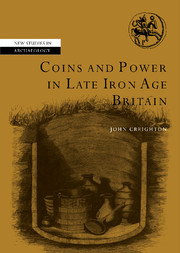Book contents
- Frontmatter
- Contents
- List of figures
- List of tables
- Preface
- Acknowledgements
- List of abbreviations
- Note on translations used
- Introduction
- 1 The Middle to Late Iron Age transition
- 2 Coin and the representation of individual authority
- 3 The Southern and Eastern kingdoms
- 4 Classical imagery and ideology in Britain
- 5 The location of Britain in the Roman world
- 6 Legends and language
- 7 Dynasties and identities
- 8 Conclusion and epilogue: from Britain to Britannia
- Appendix: A brief introduction to Iron Age coinage in Britain
- References
- Index of coin types
- General index
- NEW STUDIES IN ARCHAEOLOGY
6 - Legends and language
Published online by Cambridge University Press: 22 September 2009
- Frontmatter
- Contents
- List of figures
- List of tables
- Preface
- Acknowledgements
- List of abbreviations
- Note on translations used
- Introduction
- 1 The Middle to Late Iron Age transition
- 2 Coin and the representation of individual authority
- 3 The Southern and Eastern kingdoms
- 4 Classical imagery and ideology in Britain
- 5 The location of Britain in the Roman world
- 6 Legends and language
- 7 Dynasties and identities
- 8 Conclusion and epilogue: from Britain to Britannia
- Appendix: A brief introduction to Iron Age coinage in Britain
- References
- Index of coin types
- General index
- NEW STUDIES IN ARCHAEOLOGY
Summary
The first person to use text on coins in Britain was Commius (VA350 and 352:S6). These two coins followed the traditional serial design of an abstracted Apollo's head on one side and a horse on the other. However around the horse were placed the letters spelling out his name. The first gold issues of his successor, Tincomarus, were virtually identical (BM756:S7), but the subsequent issues marked a radical departure. As well as using classical imagery, they broadened the range of words used from a simple name to a claim of filial descent. In addition, the abbreviation of his name, TINCO, was now no longer subservient to an archaic image; instead, it was given pride of place within a tablet using carefully inscribed serifed letters (VA375:S7). Whilst inscriptions had begun simply enough with Commius' name, now legends rapidly grew in complexity.
Two features are immediately of note. First, written language on coin arrived in Britain fully developed. In certain parts of Gaul pseudo-legends had appeared on coins, as people imitated issues from the classical world. Eventually the phonetic value of various alphabets was learnt, until genuine legends came into existence. However in Britain that never happened. Commius brought with him fully developed literacy, and this was by and large in Latin. Second, we must then wonder how many people in Britain were able to read these inscriptions where proclamations of ancestry and titulature were made.
In this chapter a number of areas will be discussed.
- Type
- Chapter
- Information
- Coins and Power in Late Iron Age Britain , pp. 146 - 173Publisher: Cambridge University PressPrint publication year: 2000



